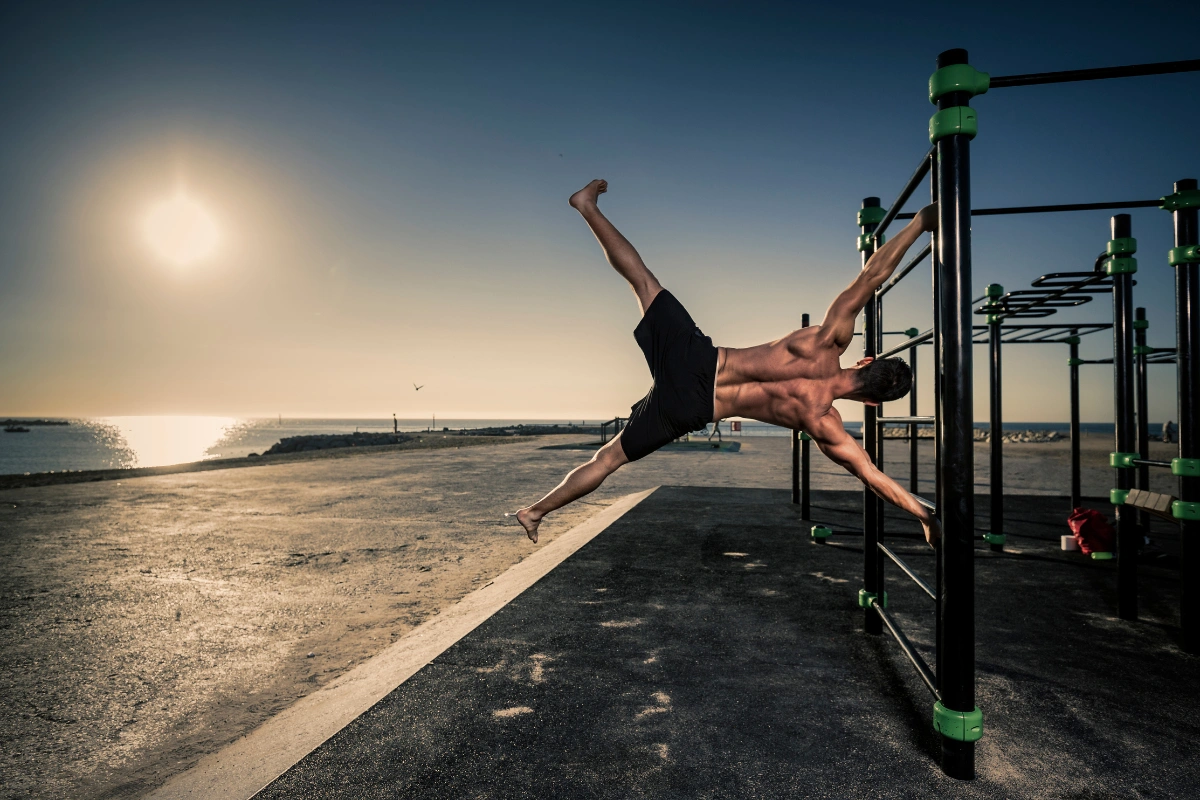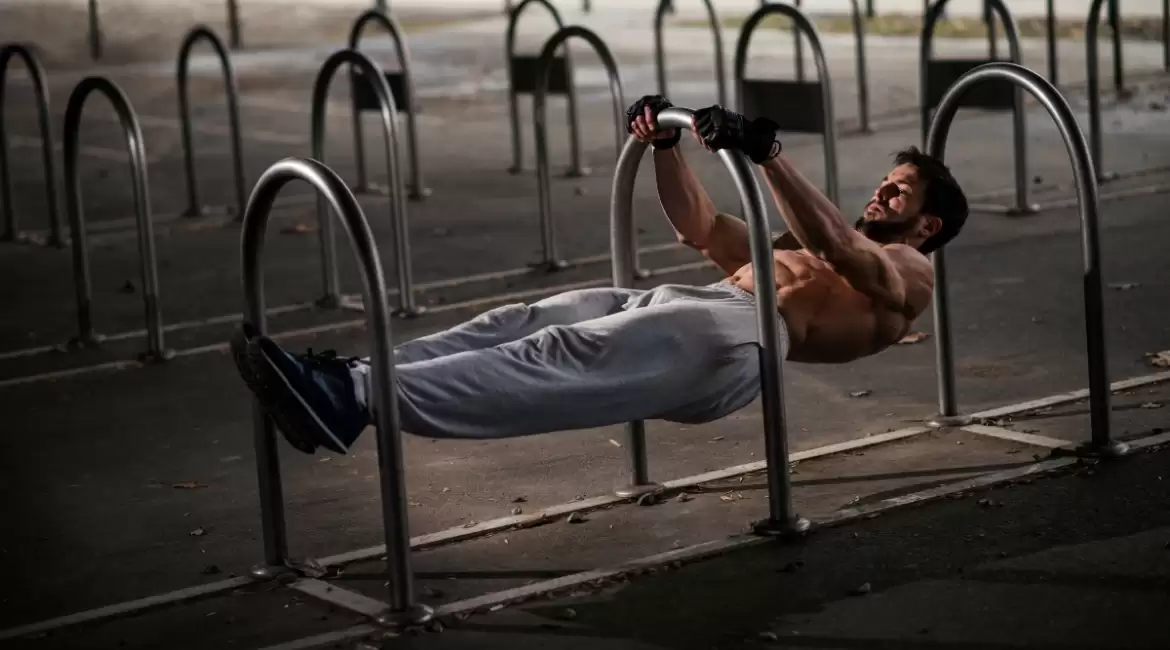In the ever-evolving landscape of fitness, calisthenics stands out as a timeless and versatile approach to achieving optimal health and strength. Rooted in ancient Greek traditions, this form of exercise harnesses the power of one’s body weight to sculpt lean muscle, enhance flexibility, and promote overall well-being. With its accessibility and myriad of benefits, calisthenics has garnered increasing popularity among fitness enthusiasts of all levels. In this post, we’ll explore the vast benefits of calisthenics and why it continues to be a cornerstone of effective fitness routines worldwide.
What is Calisthenics?
Calisthenics, derived from the Greek words ‘Kalos’ meaning beauty and ‘Stenos’ meaning strength, originally served as a means to promote health and enhance beauty and strength, particularly among school children. Over time, it has transformed into a training technique akin to gymnastics, yet distinct in its outdoor practicability, often referred to as ‘street workout’.

The Origins of Calisthenics
The roots of calisthenics can be traced back to ancient Greek, where the term originates from the combination of two words: “kálos” meaning “beauty” and “sthénos” meaning “strength.” Essentially, it involves utilizing one’s body weight and the properties of inertia to enhance physical fitness and appearance.
In essence, calisthenics embodies bodyweight strength training with an emphasis on aesthetics. This form of exercise is designed not only to build strength but also to create a visually pleasing physique. It’s evident how this dual focus has led to varying interpretations of what calisthenics truly entails.
While calisthenics gained popularity across America during the 19th century, it has often been overshadowed by more competitive sports like gymnastics in the public eye. Consequently, it became somewhat relegated to the background, evolving into an underground movement primarily practiced in urban parks, hence the term ‘Urban Calisthenics’.

The benefits of Calisthenics
No Equipment Necessary
The beauty of calisthenics lies in its accessibility—it requires no specialized equipment or costly gym memberships. With just your body and a bit of open space, you have all you need to embark on a fulfilling workout regimen. This versatility enables you to engage in effective workouts wherever you are, be it at home, outdoors, or while traveling, without the constraints of equipment availability.
Improves Functional Strength
Calisthenics exercises replicate the body’s innate movements, encompassing actions like pushing, pulling, squatting, and jumping. Engaging in this type of training enhances practical strength, which translates to improved performance in everyday tasks and sports activities. By focusing on these fundamental movements, calisthenics cultivates a holistic strength that directly benefits your day-to-day functionality and athletic prowess.
Increases Flexibility and Mobility
Participating in calisthenics necessitates performing exercises through a complete range of motion, thereby contributing to the enhancement of flexibility and mobility. Through consistent practice, calisthenics can gradually diminish the likelihood of sustaining injuries while concurrently fostering better overall health. By prioritizing exercises that promote flexibility and mobility, individuals can experience lasting benefits that extend beyond the realm of physical fitness, ultimately improving their quality of life.
Builds Lean Muscle Mass
Engaging in calisthenics involves exercises that activate numerous muscle groups simultaneously, leading to a sculpted and well-defined physique. Through regular and persistent training, individuals can progressively cultivate lean muscle tissue, thereby enhancing their overall body composition. By focusing on exercises that target various muscle groups, calisthenics facilitates the development of a leaner and more toned physique, contributing to improved aesthetics and physical performance over time.
Provides a Full-body Workout
Calisthenics routines typically incorporate compound movements, which engage multiple muscle groups simultaneously. By utilizing such exercises, individuals can efficiently target various areas of their body within a single workout session. This comprehensive approach allows for the attainment of a full-body workout in a relatively brief period, showcasing the efficiency and effectiveness of calisthenics as a form of exercise.

Calisthenics compared to Weight Training
Calisthenics and weight training each offer valuable pathways to fitness, so there’s no ‘wrong’ choice if you prefer one over the other. However, tailoring your training regimen to align with your specific fitness goals can optimize your results. Let’s delve deeper into this comparison…
For Hypertrophy
If your aim is to develop substantial arm muscles or sculpt a well-defined chest, incorporating dumbbells or barbells into your routine might be particularly advantageous. While calisthenics can certainly contribute to muscle growth, the targeted nature of weight training makes it easier to focus on specific muscle groups.
If targeted hypertrophy is your goal, picking up a pair of weights will allow you to push a muscle group closer to failure and therefore increase the likelihood of you gaining size in that specific area. While it’s possible to push a muscle group close to failure with calisthenic exercises, the resistance tends to be lower, and more muscles are involved. However, the effectiveness of each exercise can vary—those who have tried tricep dips to failure can attest to this.
For Strength
Observing the remarkable strength and lean physique of gymnasts provides compelling evidence that bodyweight exercises can indeed enhance strength.
While heavy lifting with a barbell is often regarded as the pinnacle of strength training, it’s worth considering the purpose behind it. If it keeps you consistent, motivated, and you genuinely enjoy it, aiming for impressive numbers with weights is commendable. However, many individuals with remarkable deadlift achievements find themselves challenged by exercises like the pistol squat, which demands exceptional single-leg strength.
Furthermore, calisthenics exercises offer an additional benefit—they serve as a reliable indicator of strength relative to body mass. For those with body composition goals who may fixate on the scale, achieving rep goals in exercises like press-ups or pull-ups serves as a tangible marker of progress.
For Burning Calories
While weightlifting can aid in weight loss, calisthenics emerges as a more potent option for shedding those extra pounds.
Any form of resistance training, whether it involves lifting weights or utilizing bodyweight exercises, contributes to your daily calorie expenditure. However, bodyweight workouts often involve higher repetition ranges or are structured in circuit formats, both of which can significantly boost the overall energy expenditure during the workout session.
What are Calories? Calories are a unit of measurement used to quantify the energy content of food and beverages. When we consume food, our bodies break down the nutrients (such as carbohydrates, proteins, and fats) to release energy for various physiological processes, including metabolism, physical activity, and maintaining basic bodily functions. The number of calories in a particular food or drink indicates how much potential energy it provides to the body when consumed and metabolized. Consuming more calories than the body needs can lead to weight gain, while consuming fewer calories than needed can result in weight loss. Therefore, managing calorie intake is often a key aspect of maintaining a healthy diet and achieving fitness goals.

Calisthenics Equipment
One of the wonderful aspects of calisthenics is its minimal equipment requirement, making it accessible to virtually anyone without the need for costly subscriptions. Most of the necessary equipment can often be found for free in public parks, but for those looking to practice at home, there are a few items worth considering.
Investing in four key pieces of equipment can greatly enhance your calisthenics journey: a home pull-up bar, gymnastics rings, parallettes for dip practice, and resistance bands. These tools offer versatility and can cater to individuals at various skill levels, whether they’re beginners or aspiring to reach the prowess of calisthenics icons like Hannibal for King.
The more equipment you have, the more exercise variations you can explore. However, when it comes to essentials, I can effectively train my clients with just rings, a pull-up bar, and a dip bar. Similarly, for my own advanced training, these basic pieces of equipment suffice.
Summary
Calisthenics, an age-old fitness regimen originating from ancient Greece, has resurged in popularity due to its simplicity, accessibility, and profound health benefits. This form of exercise, which utilizes the body’s own weight as resistance, offers a comprehensive workout that targets multiple muscle groups simultaneously. From enhancing strength and flexibility to promoting cardiovascular health and aiding in weight loss, calisthenics caters to individuals of all fitness levels and goals. Furthermore, its minimal equipment requirements make it a practical choice for anyone seeking to embark on a fitness journey without the need for expensive gym memberships or specialized gear. As we delve into the depths of calisthenics and its immense benefits, it becomes evident that this age-old practice remains as relevant and impactful as ever in today’s health and wellness landscape.


Leave a reply